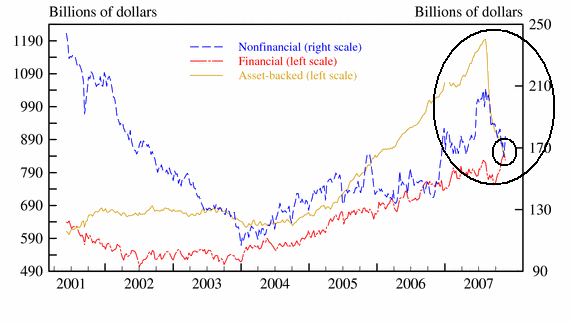The Federal Reserve took steps to stabilize a jittery financial system, though the moves did little to ease the fears of many investors, who flooded into the safety of Treasurys amid mounting economic worries.
.....
Yet, in the starkest sign of the growing unease in the credit markets, the yield on 10-year Treasury notes dropped sharply to 3.848%, the lowest level since March 2004, from 4.012% Friday.
Investors are worried that financial institutions could be on the hook for growing losses because of exposure to soured mortgage investments. More fundamentally, they fear a recession.
.....
Since August, banks have been reluctant to lend even to each other for more than a few days. It has been for a variety of reasons: a need to have cash on hand to fund unanticipated commitments; possible mistrust of each other's creditworthiness; and a greater-than-usual aversion to showing a shortage of cash at year end.
The last paragraph illustrates the basic problem in the credit markets. It has nothing to do with liquidity and everything to do with faith in the guy you're lending too. If you think a borrower isn't going to repay his loan you're not going to lend him any money no matter how much money you have to lend. It's that simple.
To illustrate this point, here is a chart from the Federal Reserve of outstanding commercial paper. I circled the decline in asset-backed paper and added a small circle to show where current levels are.

There is still a great deal of concern out there about lenders. So long as that concern exists, we're going to have problems.
If you gave me a trillion dollars and I didn't think there was a place to invest it, I'd be parking that money in Treasuries too.